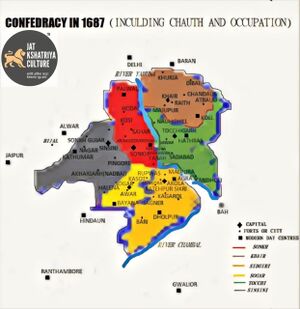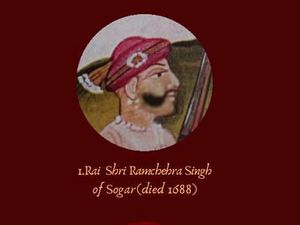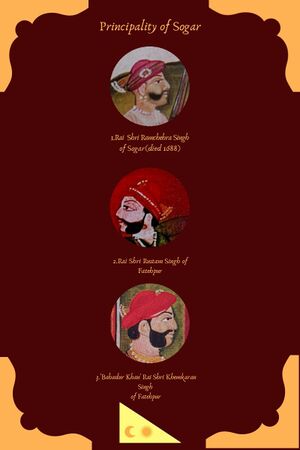Ramchehra
Ramchehra (born:?-died:1688) was a Sogarwal Jat Chief from Sogar (4 miles south-east of Bharatpur), who formed a federation of Sinsinwars and Sogarias with Rajaram known as Sin-Sog.
Contents
Sogaria Pal
Sogaria Khap is spread over Bharatpur and Agra Janapadas. Sogar and Tuhiya were its famous villages ruled by Jats. Ramchehra was of this khap who formed a federation of Sinsinwars and Sogarias with Rajaram known as Sin-Sog. The people of this khap were always in fight with the Mughal Ruler Aurangjeb. They brought the ashes of Akbar from Sikandarabad burial site and burnt it.[1]
History
Sogarwars are descendants of Yaduvanshi or Chandravanshi Kshatriyas. There was a famous warrior in Sogarwar clan named Sugriv (सुग्रीव). He founded the present Sogar town in Rajasthan near border of Uttar Pradesh. He also constructed fort here, which was known as Sugrivgarh. Sugrivgarh is now known as Sogar. There is a math of Sugriv here. All Sogarwars used to keep some grains separate for him when harvesting crop. During marriages also they offer Rs one for Sugriv math.[2]
Khemkaran was warrior born in Sogarwars. He was prior to Maharaja Suraj Mal. He had stopped all the roads for Aurangzeb. He along with his friend Ramki Chahar created a terror in Agra, Dholpur and Gwalior regions. The Mugal sardars were terrified of him. Bharatpur was part of his state. He was also a kind hearted and charitable person. He is said to be so strong that he could kill two tigers at a time on both sides with a katar. Mugal Badsah had awarded him the title of Faujdar. The Kuntal ruler of Ading state had poisoned him.
Faujdar was a title awarded by Muslim rulers to people who had responsibility of protecting some territory. Sogarwar, Chahar, Sinsinwar, Kuntal etc Jat gotra people use this title.
Birth of Jat confederacy
Dr Girish Chandra Dwivedi [3] mentions that .... Raja Ram displayed a capacity to learn from the past and an insight into the exigencies of the present. He could infer from Gokul's example that lack of training and proper equipment, pitched contest against the powerful Mughal army and weak Jat defences were the precise reasons of the Jat debacle in 1669-1670. His reorganisations bears testimony to it that he tried to remove these glaring defects. He knew that the gallant Jats could give an impressive account of the selves under one leader. With this end in view he allied his Sinsinwara clansmen with the Sogaria
[p.34]:Jats under Ramachehara, who possessed the castle of Sogar [4] (4 miles south-east of Bharatpur). He fraternised with the Jats of Sidgiri region[5] (Bayana, Rupbasaia). He also befriended the Jats of Ranthambhor against the Amber ruler, Ram Singh. [6] On the basis of the contemporary despatches it can unmistakably be deduced that Raja Ram proved a great rallying point and a great number of the Jats were united under his leadership.[7]
Jat confederacy in Braj region in 1687

These were region in control of Jat confederacy in Braj region during 1687. Jats carved out 6 principalities out of Mughal Empire after the death of Veer Gokula Singh of Tilpat. These Principalities were
Source - Jat Kshatriya Culture
Death of Ramchehra
Dr Girish Chandra Dwivedi [8] mentions that .... During these days the existing feud between the Chauhans and the Shekhawat Rajputs over disputed land in Bagtharia (22 miles nort-east of Alwar) and some other parganas had erupted into an open war. The Chauhans appealed to Raja Ram for help, while the Shekhawats implored the help of Murtaza Khan, the Mughal faujdar of Mewat. Bidar Bakht, Rao Raja Anirudh Singh of Bundi and Maharao Kishor Singh Hada joined the faujdar and the Shekhawats. A severe battle was fought near Bijal. Opposite Raja Ram was the Hada Chief upon whom he inflicted a crushing defeat. Anirudh Singh himself could not stand before the Jat on set. He became nervous and fled along with his troops. When the Battle was in its full fury the gallant Raja Ram led a fierce charge against the centre, consisting of the Mughals. Meanwhile, a Mughal musketeer, who had hidden himself in a tree, fired Raja Ram at his chest. He fell down from his horse and died immediately (Wednesday, 4th July, 1688- 15th Ramzan, 1099 A.H.). His fall signalled the defeat of the Chauhans. Raja Ram's head was severed from the body and later on presented to Aurangzeb in the Deccan (5th September- 9th Zi-Qada, l099 A.H.). Ramchehara was captured alive in this battle. He was subsequently beheaded and his head was publicly exposed at Agra.[9]
Chronology of rulers of Sogar
The principality of Sogar was carved out of Mughal empire by Rai Ramchehra Singh of Sogar who was an close associate of Raja Ram Singh (also know as Raja Ram Jat, one who ended Mughal rule in Agra Subah).
Rai Ramchehra Singh was succeeded by Rai Rustam Singh Sogarwar who shifted his capital and founded the city of Fatehpur (later Bharatpur), Rustam Singh fought in the Jat-Mughal War (1688-95).
Rustam Singh was succeeded by Khan Bahadur Rai Khemkaran Singh Sogarwar who was the most ablest of the Sogarwars. He received Khilat and title of 'Bahadur Khan (Brave Chief)' from Emperor Farukhsiyar (as Mughal wanted to pacify Jats). He also had an important role in making Mohamad Shah the emperor. After the death of Rao Churaman Singh of Thun, the civil war started between the Jats in which Sinsinwar emerged as the leading canton. Khan Bahadur Rai Khemkharan Singh was the biggest threat to Raja Badan Singh of Deeg. Kunwar Suraj Mal ( Sujan Singh) annexed the principality of Sogar (Khemkaran died in the Battle of Fatehpur). The Fort of Fatehpur was reconstructed and named Bharatpur. The other Sogarwar Chiefs i.e Thakur of Awaeyr, Thakur of Tuhia and Thakur of Sewar soon accepted the rule of Maharaja Badan Singh.
Source - Jat Kshatriya Culture
External links
References
- ↑ Dr Ompal Singh Tugania: Jat Samuday ke Pramukh Adhar Bindu,p.22
- ↑ Thakur Deshraj: Jat Itihas ,p. 557
- ↑ Dr Girish Chandra Dwivedi: The Jats - Their Role in the Mughal Empire/Chapter II,pp.33-34
- ↑ Memoires des Jats (Fr. Ms.), 9, 10.
- ↑ Vanshbhaskara, 2886.
- ↑ Ram Pande,Bharatpur, 8, 10.
- ↑ Infra, See Ch. II, Estimate of Raja Ram.
- ↑ Dr Girish Chandra Dwivedi: The Jats - Their Role in the Mughal Empire/Chapter II,pp.37
- ↑ Ibid., 134a-135a; J. Records. XII, 1,7; Maasir. 311-312; MU, I,438, cf. Kamwar (Pers Ms.), II. 231; Memoires des Jats (Fr. Ms., I11 - 12) says that Raja Ram succumbed to his wounds, sustained while being pursued: M.L. Sharma Kota Rajya Ka ltihas, 207-209.
Back to The Rulers

